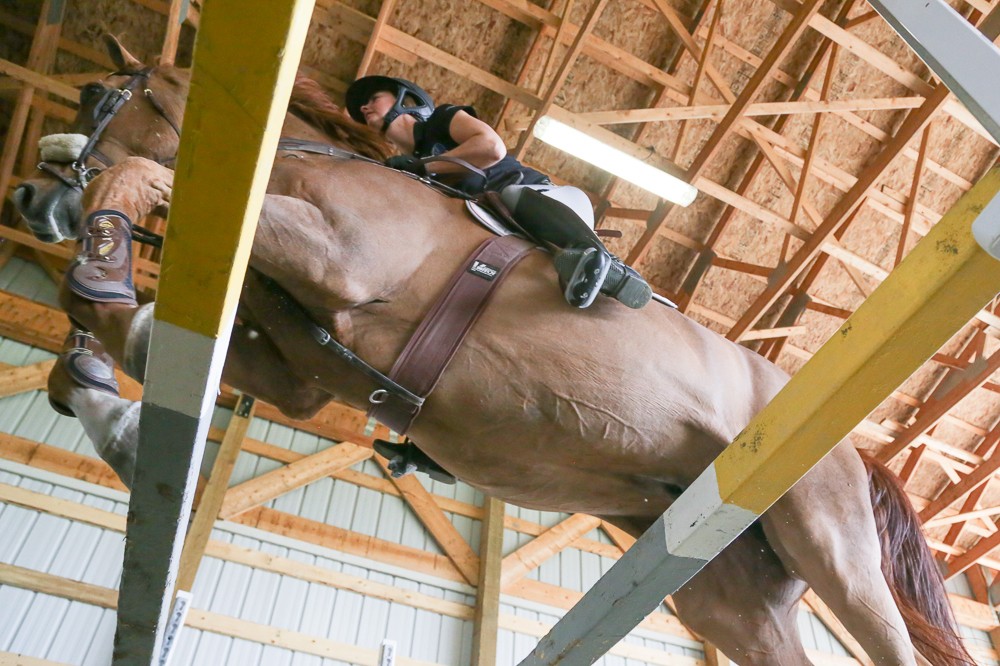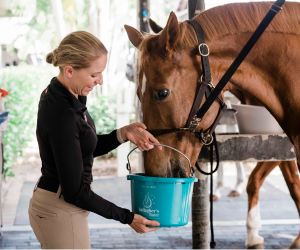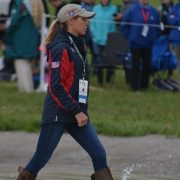All Ankles and Elbows: Grand Prix Jumper Jenna Ritchie on Proper Release

What do you think about when you’re sailing in the air over a jump? Perhaps your posture, or the position of your lower leg? The direction of your gaze, finding the path to the next obstacle? Maybe you’re thinking about your release – the placement and feel of your hand.
Think about what happens when a horse takes off over a jump. There are so many variables; whether the distance was short or long, your horse’s jumping style, how your horse reacts to the jump (LIVERPOOL!) that your body needs to react to. Staying strong and balanced in these circumstances is difficult as it is, but then you have a sensitive equine mouth on the end of a pair of leather straps to worry about. This is where releases come in – they help your hands stay out of (the horse’s) harm’s way over a jump.
Hanging onto a physical handle, like a martingale or neck strap, is ideal for beginners. The next step is crest releases, in which the rider presses their hands into the horse’s neck, at varying positions depending on their skill, the horse, and the discipline.
When your balance is honed to the point where your body can be trusted to operate independently from the horse, an automatic or ‘following arm’ release can be used to stay in communication with the horse mid-air – which can save valuable seconds on tight courses. Jenna Ritchie, a grand prix show jumper and trainer from Vancouver, works on these challenges in her own riding and with her students.
Heels Down Mag caught up with her to get the secrets to a great release. Spoiler alert: there are no easy hacks.
Let’s talk fitness – and teamwork
Jenna’s physical fitness journey was emphasized by her return to riding after the birth of her child by c-section. “I lost my balance,” she said. “I had to completely retrain my core for riding.” She recruited a powerlifting coach and a chiropractor, who work together as a team to improve her strength and balance. They come to Jenna’s facility together to watch her ride – and compare her athletic performance to videos of Scott Brash. What’s more, they have each other’s phone numbers and don’t hesitate to ring each other up if they have a question or idea during one of Jenna’s treatments or sessions.
Such close attention to detail helps with the small nuances of riding that can make a huge impact on overall performance. “They’ve taught me to be more aware of small pains and pulls,” Jenna explained. “I have a very high pain tolerance, so that made me more prone to ignore these things. Pain is not always negative – it’s useful information when it comes to physical fitness.” It has also inspired her to be similarly vigilant to these small weaknesses in her students, she said.

Flexible elbows
When asked about the moment she achirved the “holy grail” of releases – the automatic or following arm release – Jenna said that her elbows played a huge part. Being conscious of “unlocking” the elbow in all three gaits, and even exaggerating the movement slightly in the walk, was a breakthrough. Fellow grand prix rider Kyle King even specifically remarked on “how good her arms look,” she remembers.
Like This Story? Read This One Next: Try These Stretching Exercises To Be More Supple In The Tack
Although elbows are not paid very much attention, they are the link between a rider’s body, which moves, and their hands, which stay still. That inconspicuous joint has an important job to do – which is to stay relaxed.
Strong ankles
“Your ankles are your foundation. They’re holding your whole body,” Jenna described. It’s a very true statement, and somewhat revelatory in its simplicity. When do we ever think much about our ankles, other than ‘heels down’? Seeing as the ankle and heel – not the rest of the foot – is what is closest to the ground when jumping, weakness in it would cause a ripple effect in the rest of the leg (and then seat, and torso, and hands).
Jenna went on to tell me about a student of hers, whose weak ankles were the major roadblock in moving from a crest release to following hand release. “The stability was just not there,” Jenna said. She helped the rider out with supplementary exercises to isolate the muscles needed for stronger ankles.
When you think about it, it’s rather poetic that a release is heavily affected by the elbows and ankles. Your elbows are closest to your hand, while your ankles are farthest away. These little joints play a big part in your overall balance, and therefore your release.


